It’s a common phenomenon among competitive swimmers to shave their bodies before big swimming competitions and as strange as it may sound to your average non-swimmer, it’s considered completely normal among these aquatic athletes. So with that said, you are probably wondering why do swimmers shave? Or maybe you are a swimmer yourself and you are new to the tradition and would like to know a bit more.
Whatever the case, in today’s article we’ll cover everything surrounding swimming and shaving as well as some cool studies that dive a bit deeper to find out how much of a physical difference it can really make in terms of swimming performance in the pool.
In short: Shaving holds both physical and psychological benefits for swimmers. Swimmers shave their entire bodies to get rid of body hair in return allowing for reduced drag in the pool. Shaving also helps swimmers to gain a better feel for the water by removing dead skin cells.
Why Do Swimmers Shave? The Science Behind It
If you ask any competitive swimmer as to why they shave before a big swimming competition, they’ll probably tell you that it’s because it helps them to swim faster by cutting down on drag caused by body hair in the water.
And although the idea definitely makes sense, you may be wondering if this can really make any significant difference in terms of swimming performance and times in the pool. For this purpose, we’ll be taking a look at 2 scientific studies-
Shaving Reduces Blood Lactate Levels by Lowering Drag
The first study we are looking at was conducted at the Exercise Physiology Laboratory at Iowa State University. The study investigated the effect of shaving body hair on the physiological cost of freestyle swimming.
For the study 6 elite-level, college swimmers volunteered and were asked to complete four 200 yard freestyle swims with roughly 15 minutes of rest between each. Swimmers were also asked to reduce their times by roughly 10 seconds on each consecutive swim.
This process was repeated twice, first with the swimmers unshaved, and then again the following day after all the swimmers shaved their arms, legs, and exposed torso.
To measure the physical cost of swimming blood lactate concentration was taken 2 minutes after each of the four 200 yard freestyle swims.
So what did the study find you are probably wondering? Well, it was determined that at peak swimming speed of 1,30 m/sec blood lactate concentration was significantly reduced by an average of 23%, leading to the conclusion that there indeed is quite a physical benefit to shaving down before a big swimming competition, most likely due to lower body drag in the water.
For those that aren’t aware, blood lactate is an intermediate product created during the process where glucose is broken down, elevated lactate levels can reflect a wide variety of things, including overuse of the physical systems in your body.
Below is a chart showing the differences in blood lactate levels of the swimmers before shaving compared to after shaving-
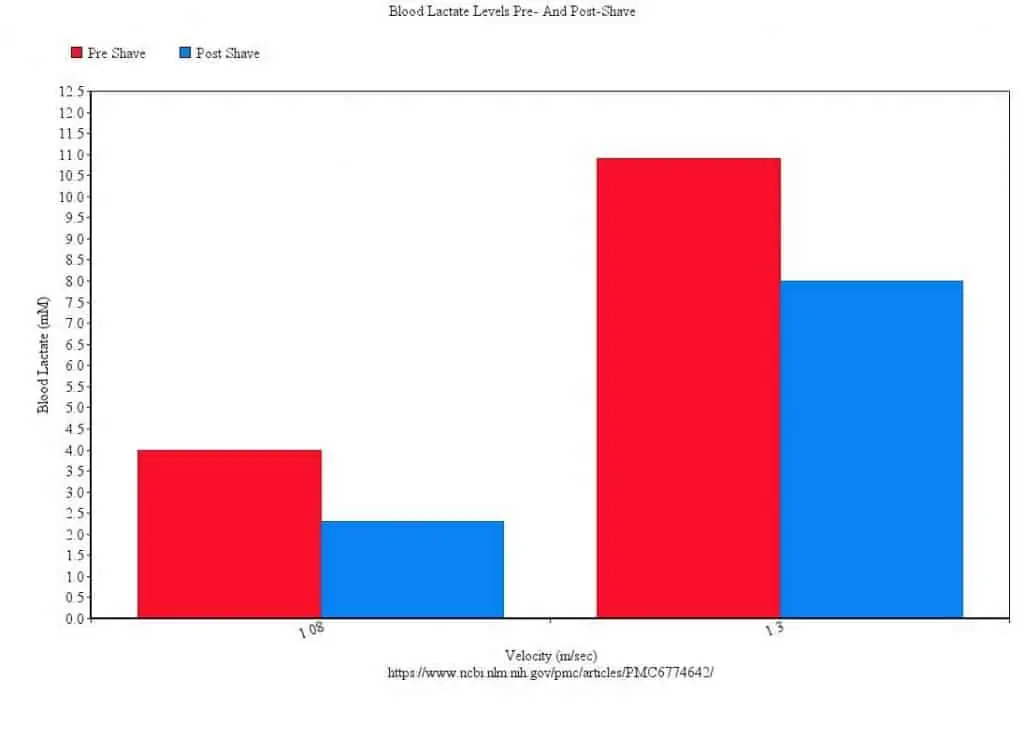
Shaving Improves Distance Per Stroke and Lowers VO2 Levels as Well as Blood Lactate Concentration
In another study published in the Journal of Med Science Sports Exercise, the influence of body hair removal on the physiological responses during breaststroke swimming was investigated.
In the study, 9 male collegiate swimmers were studied before- and after shaving their arms, legs, and exposed trunk. Additionally, there was a control teammate that participated in both of the swims but did not shave during either one.
For this study distance per stroke, VO2, heart rate, and post-swim blood lactate levels were measured to determine the physical cost of swimming pre- and post-shave.
After completing a breaststroke swim at approximately 90% effort it was determined that the shaved group experienced a significant decrease in blood lactate concentration, a decrease in VO2, and an increase in distance per stroke while heart rate stayed roughly the same.
It’s also important to note that the control group did not show any changes in V02, heart rate, blood lactate concentration, or distance per stroke.
In a separate group of swimmers consisting of 9 shaved swimmers and 9 controls, it was found that shaving greatly reduced the rate of velocity decay following a prone glide after a maximal underwater push off from the wall.
Similar to the first, this study also concluded that shaving reduced active drag, therefore decreasing the physical cost of swimming and contributing to faster times in the pool.
Shaving Helps Swimmers to Gain a Better Feel for the Water
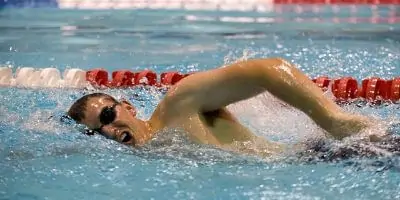
Now that we’ve seen how shaving can actually contribute to faster swimming by helping swimmers to cut down on drag in the water, we are going to look at another physical benefit that shaving holds for swimmers.
This one probably isn’t as obvious as the first but still contributes to faster swimming. So what is it? Well, as you have probably already been able to tell from the subtitle, shaving actually helps swimmers to gain a better feel for the water as well as more physical awareness while swimming.
But how exactly does shaving do this? Well, apart from removing excess body hair shaving also removes the outer top layer of dead skin cells. Naturally, your body is slowly going to shed away these cells over time anyway, but the use of a razor significantly speeds up the process by removing all of the dead cells at once leaving behind a slick and smooth sensation with freshly exposed skin cells.
If you’ve ever put on a pair of long pants or jumped under your sheets after shaving your legs you have probably felt that very smooth and fresh sensation. Well just like that swimmers can instantly feel their entire body when jumping in the water after a full-body shave due to all of the newly exposed cells.
Personally, I find this sensation to be most prominent when jumping in for your first warm-up swim of that long 5-day swim meet, and then it will slowly start to fade away as your skin adapts to the sensation of the water and hair starts to grow back. This is also the reason why some swimmers, myself included, will shave upwards of 2 to 3 times during a long swim meet- to help maintain that body awareness in the pool.
Psychological Benefits of Shaving for Swimmers

Apart from the physical benefits that shaving holds for swimmers in the water, there are also psychological benefits to the tradition. And while these might not be as measurable as the physical ones, they are certainly there and many competitive swimmers can attest to that.
So what psychological benefits does shaving hold? Well, firstly as crazy as it sounds if you believe that you are meant to swim faster after shaving you most likely will. Another psychological benefit is that of a pre-race or in this case possibly a pre-meet routine.
In the weeks leading up to a big swimming competition, many swimmers will go through a very hard block of training pushing their body to the limit in every way possible, whereafter they’ll do a taper of around 2-3 weeks (or sometimes even longer) allowing their body to rest and recover in order to swim as fast as possible.
Then in the days before the competition training load will significantly decrease and swimmers will already be in the mentality to race. Shaving is usually done a day before the actual competition starts and can be seen as one of the final parts of preparing for that big swimming competition.
When you have been swimming for many years and gone through this process of preparing for a big swimming competition you create a routine that gets drilled in and signals to both your mind and body that it is time to swim fast, and shaving usually forms part of this routine creating that psychological boost that improves physical performance in the water.
Related: Motivational Swimming Quotes For Competitive Swimmers.
How to Shave for Swimming
Now that we’ve covered all of the benefits that shaving holds for swimmers, let’s have a look at how you actually shave for a big swimming competition.
Where to Shave?
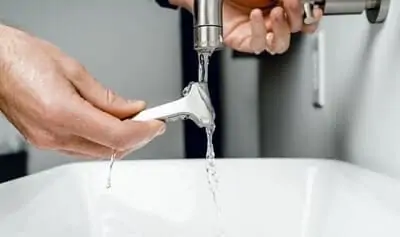
The first thing you are probably wondering is what parts of your body to shave? As we’ve seen from the studies above the participating swimmers were in both cases asked to shave their legs, arms, and trunk, resulting in a near full-body shave.
For the majority of swimmers, especially those who are new to the tradition it isn’t necessary to shave your entire body, although you could if you wanted to. For the most part, I’d say shaving your legs is going to be a good start for the majority of swimmers while you can then also shave your arms if you’d like to.
Usually, I shave my arms and legs before an important swimming meet, while I will in fact do a full-body shave when competing at nationals.
In short- Elite level competitive swimmers usually shave their entire body before a big swimming competition. This includes their legs, arms, trunk, chest, and even their back. This, however, isn’t necessary for your average competitive swimmer. Shaving your legs and arms will be more than enough.
Something to note is that world-class swimmers also shave their palms and feet. Apparently, this technique helps to significantly increase your feel for the water by removing dead skin cells in those areas. Shaving here isn’t necessary but you can give it a try if you feel like it.
Do Swimmers Wax or Shave?
A commonly asked question is whether or not you should shave or wax before a big swimming competition.
It is recommended that swimmers shave as this is going to remove the outer layer of dead skin cells as well as body hair, whereas waxing alone is only going to remove body hair. Waxing can, however, initially be used to clear some hair making the shaving process easier.
The Shaving Process
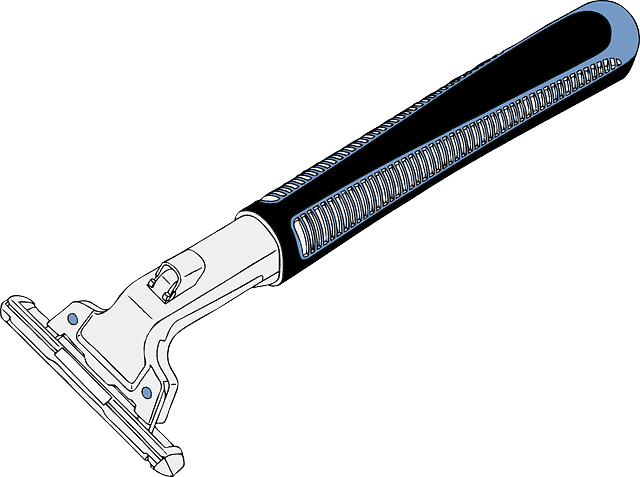
The first step of the shaving process is going to be to gather everything you are going to use. Here is a quick list of some recommended items-
- Disposable double blade razors.
- Shaving cream, menthol-scented cream works the best.
- Clippers, if you have a lot of hair.
Usually, swimmers start the shaving process by first going over their body using a pair of electric clippers, such as those used at your barber. Clippers will help to clear a lot of the excess hair on your body, ultimately saving you a ton of time and razor blades as shaving with a razor alone is going to be a lot of work.
Clippers aren’t too expensive and can easily be bought online.
After you’ve clipped off the majority of the body hair, you can take your shaving cream and apply a good amount on whichever area you’d like to shave first. I usually start with my legs as this has one of the biggest surface areas.
Once you applied the shaving cream, you can start shaving with your razor. As already mentioned it is recommended to use a disposable double-blade razor since you will most likely use it up and double-blade razors are the most effective for clearing body hair and dead skin cells.
If you need a razor, consider checking out this cheap and quality pair:
The most effective way of shaving is to use a saw-like motion where you are moving the razor back and forth along the grain of your hair. This technique is more effective than the traditional rinse technique as it saves more time and clears more hair.
The up-stroke will shave off the hair while the downstroke will quickly and effectively clear of the hair. Surprisingly this technique also keeps your razor sharp for longer as constantly rising it off can cause it to become blunt quicker.
Repeat this technique across all of the areas of your body where you’d like to shave until your skin is smooth and rid of body hair.
Do You Want to Make Every Lap Count?
Stop wasting your time in the pool feeling lost and doing directionless swim workouts, and start training effectively! Our ebook contains 97 structured and goal-orientated swim workouts to help you become a better, faster, and fitter swimmer. Whether you’re a complete beginner or a seasoned pro, there are a multitude of workouts for every type of swimmer.
Reshaving During a Long Swimming Meet
Many competitive swimmers will compete in meets lasting 3-5 days. During this period you will most likely lose that smooth and fresh sensation after your first day or two of racing. To combat this you can consider doing a reshave which will then bring that sensation back and help you to feel fast and aware in the water.
For the reshave, you want to use a new and sharp razor to ensure maximal efficiency. This time, however, instead of shaving up and down, you want to shave left and right against the grain of the hair. This will skim off dead skin cells but won’t aggravate the fresh hair stubble that can lead to painful ingrown hairs.
Quick Shaving Tips for Swimmers
1. Use Rubbing Alcohol or Baby Oil Afterwards
After shaving it’s a good idea to use some rubbing alcohol on your skin. This is going to open up pores, which are essentially tiny differentially permeable gaps in your skin that allows certain substances to travel through, essentially enhancing your feel for the water.
Secondly, the alcohol rub is also going to refresh your skin even more than the menthol shaving cream did and will sterilize any cuts that you may have made while shaving as well as stopping ingrown hairs from occurring.
Applying the baby oil is optional. This is for swimmers who find their skin to be very dry after shaving. The baby oil will essentially moisturize your skin. Just apply a light coat over the shaved areas.
2. Have a Partner Near
When shaving your whole body there are a lot of awkward spots that are hard to reach. If you try to shave these areas on your own you may end up cutting yourself, missing them all together or maybe even pulling a muscle which definitely wouldn’t be ideal.
It’s recommended to have someone nearby who can help you to shave these areas. A lot of the time on swimming tours teammates will help each other to shave areas that are hard to reach such as your back. But if you are at home you can ask a family member or good friend.
3. Shave the Night Before Your Swimming Meet
If you’re like me and you don’t shave to often, then shaving can become a very long process. It’s recommended to shave the night before your meet so that you have enough time to get it done without getting stressed out being late for the meet.
Shaving the night before will also give any cuts that you may have made a bit of time to heal which will prevent infection, especially if you are swimming an open water race. I’d say give yourself a minimum of 90 minutes for the whole process, but if you are quite hairy then you may need extra time.
4. Don’t Stay in One Position for Too Long
When shaving certain areas of your body it is common to sit in one position for quite some time to get that area finished up. However, this can cause muscles to become tight, which definitely isn’t ideal if you are racing the next day.
Make sure to frequently switch positions to avoid getting too tight. It’s also a good idea to have a light stretching session afterwards and to foam roll your muscles to get rid of any tight areas that may have been created while shaving.
5. Avoid Using Lotion After Shaving
Unlike the rubbing alcohol, moisturizer is going to clog up the pores in your skin and reduce your feel for the water when jumping in to swim the next day. If you’ve shaved certain sensitive areas that may get a rash easily, such as your armpits, you can still use a bit of moisturizer there to avoid that.
But as mentioned earlier, baby oil is generally your best bet for keeping your skin in prime racing condition if you tend to have dry skin after shaving.
The History of Swimming and Shaving: a Quick Overview
The history of swimming and shaving is quite blurry but dates back to around the 1950s where it was first introduced by Jon Henrick of Australia at a swimming meet in 1955. The next year, at the Melbourne Olympic Murray Rose of Australia also shaved for the meet. Subsequently, the Australians won the majority of the swimming events that year. (Could this have had anything to do with the shaving?).
At first, the Americans believed that shaving didn’t have anything to do with the success of the Australian swimming team but after the 2 Australian Olympic swimmers, namely, Henricks and Rose introduced the practice of shaving in the United States after arriving there to train at the University of Southern California in 1957 the practice quickly caught on and spread like wild-fire all around the world.
By the 1960s most of the US swimmers were shaving for the Olympics and other major swimming competitions and the rest of the world soon followed as well.
Since then swimming has evolved a lot with the introduction of all sorts of new training styles and swimming technologies such as tech suits, but still, the tradition of shaving remains and will continue to remain.
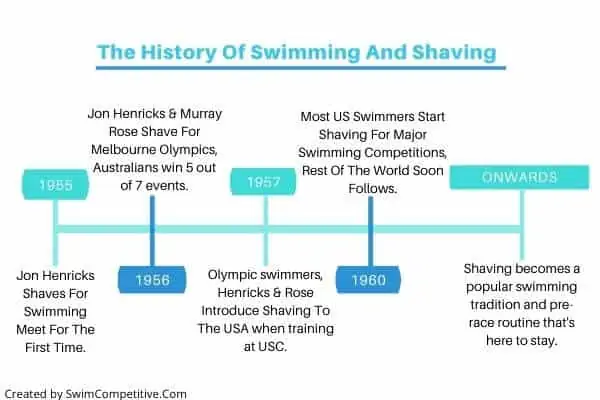
FAQ: Common Questions About Swimming and Shaving
How Often Should Swimmers Shave?
Swimmers are encouraged not to do a full-body shave more than once every swimming season and no more than 3 times per year. You can shave your legs more than once per season for smaller important meets as well. This will preserve the unique sensation for when it is time to swim fast.
The key here is not too shave to often. Ideally, you want to save it for when it really matters, this gives hair time to grow out and dead skin cells to accumulate which will then provide an unique and fast feeling in the water when you finally shave it off.
If you are a female swimmer, you can go about your normal shaving routine, but you should stop shaving completely a month or two before a big swimming competition so that you too can experience this sensation in the water.
Do Swimmers Shave Their Eyebrows?
No, swimmers do not shave their eyebrows. The eyebrows are one of the few areas that swimmers do not shave as it only covers a small surface area and will look quite strange being shaved. Furthermore, the eyebrows are in a lot of cases partially covered by swimming goggles.
Should Swimmers Shave Their Armpits?
Most swimmers will shave their arms and armpits when preparing for a big swimming competition. Shaving your armpits is, however, optional as it can be uncomfortable if done incorrectly and only covers a small surface area in the water, unlike some other body parts such as your legs.
If you do decide to shave your armpits, I recommend using a sensitive skin shaving cream for this area and not a menthol cream. It’s also a good idea to apply a small amount of skin lotion of some sort to this area afterward to prevent any rash from occurring.
Why Do Swimmers Not Shave?
Swimmers are generally asked not to shave a month or two leading up to a big swimming competition. This allows for hair to grow out creating drag in the water when training. Swimmers will then shave right before the competition leading to a smooth and fast feel in the water.
As already briefly mentioned it is recommended not to shave for at least 1 to 2 months leading up to a big swimming meet, although the longer you avoid shaving the better.
Why Do Swimmers Shave Their Legs?
Some swimmers may choose to shave only their legs before a swimming competition and not necessarily their entire body. This is done as the legs are generally easy to shave and cover a large surface area of the body still ensuring enhanced performance while swimming.
Do Swimmers Shave Their Arms?
Swimmers shave their entire bodies, including their arms, legs, torso, chest, and back. The arms cover a large surface area of the body and are therefore an important area to shave as it will help to lower drag and increase the swimmer’s feel for the water.
Swim Faster by Shaving
Shaving is a popular pre-meet tradition among swimmers from all levels, no matter if you are an age-group or Olympic level swimmer. In many cases, swim coaches themselves urge swimmers to shave before a big upcoming swim meet. To many it might seem strange, but as we’ve seen in this article there are clear performance benefits to shaving before a swim meet.







